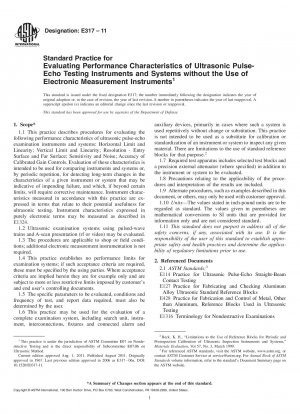ASTM E317-11
Standard Practice for Evaluating Performance Characteristics of Ultrasonic Pulse-Echo Testing Instruments and Systems without the Use of Electronic Measurement Instruments
- Standard No.
- ASTM E317-11
- Release Date
- 2011
- Published By
- American Society for Testing and Materials (ASTM)
- Status
- Replace By
- ASTM E317-16
- Latest
- ASTM E317-21
- Scope
This practice describes procedures applicable to both shop and field conditions. More comprehensive or precise measurements of the characteristics of complete systems and their components will generally require laboratory techniques and electronic equipment such as oscilloscopes and signal generators. Substitution of these methods is not precluded where appropriate; however, their usage is not within the scope of this practice.
This document does not establish system acceptance limits, nor is it intended as a comprehensive equipment specification.
While several important characteristics are included, others of possible significance in some applications are not covered.
Since the parameters to be evaluated and the applicable test conditions must be specified, this practice shall be prescribed only by those familiar with ultrasonic NDT technology and the required tests shall be performed either by such a qualified person or under his supervision.
Implementation may require more detailed procedural instructions in the format of the using facility.
In the case of evaluation of a complete system selection of the specific tests to be made should be done cautiously; if the related parameters are not critical in the intended application, then their inclusion may be unjustified. For example, vertical linearity may be irrelevant for a go/no-go test with a flaw gate alarm, while horizontal linearity might be required only for accurate flaw-depth or thickness measurement from the display screen.
No frequency of system evaluation or calibration is recommended or implied. This is the prerogative of the using parties and is dependent on application, environment, and stability of equipment.
Certain sections are applicable only to instruments having receiver gain controls calibrated in decibels (dB). While these may sometimes be designated “gain,” “attenuator,” or “sensitivity” on various instruments, the term “gain controls” will be used in this practice in referring to those which specifically control instrument receiver gain but not including reject, electronic distance-amplitude compensation, or automatic gain control.
These procedures can generally be applied to any combination of instrument and search unit of the commonly used types and frequencies, and to most straight-beam examination, either contact or immersed. Certain sections are also compatible with angle-beam, wheel, delay-line, and dual-search unit techniques. Their use, however, should be mutually agreed upon and so identified in the test report.
The validity of the results obtained will depend on the precision of the instrument display readings. This is assumed to be ±0.04 in. (±1 mm), yielding between 1 % and 2 % of full scale (fs) readability for available instrumentation having suitable screen graticules and display sharpness.
1.1 This practice describes procedures for evaluating the following performance characteristics of ultrasonic pulse-echo examination instruments and systems: Horizontal Limit and Linearity; Vertical Limit and Linearity; Resolution - Entry Surface and Far Surface; Sensitivity and Noise; Accuracy of Calibrated Gain Controls. Evaluation of these characteristics is intended to be used for comparing instruments and systems or, by periodic repetition, for detecting long-term changes in the characteristics of a given instrument or system that may be indicative of impending failure, and which, if beyond certain limits, will require corrective maintenance. Instrument charact......
ASTM E317-11 Referenced Document
- ASTM E114 Standard Practice for Ultrasonic Pulse-Echo Straight-Beam Examination by the Contact Method
- ASTM E127 Standard Practice for Fabricating and Checking Aluminum Alloy Ultrasonic Standard Reference Blocks
- ASTM E1316 Standard Terminology for Nondestructive Examinations
- ASTM E1324 Standard Guide for Measuring Some Electronic Characteristics of Ultrasonic Testing Instruments
- ASTM E428 Standard Practice for Fabrication and Control of Metal, Other than Aluminum, Reference Blocks Used in Ultrasonic Testing
ASTM E317-11 history
- 2021 ASTM E317-21 Standard Practice for Evaluating Performance Characteristics of Ultrasonic Pulse-Echo Testing Instruments and Systems without the Use of Electronic Measurement Instruments
- 2016 ASTM E317-16 Standard Practice for Evaluating Performance Characteristics of Ultrasonic Pulse-Echo Testing Instruments and Systems without the Use of Electronic Measurement Instruments
- 2011 ASTM E317-11 Standard Practice for Evaluating Performance Characteristics of Ultrasonic Pulse-Echo Testing Instruments and Systems without the Use of Electronic Measurement Instruments
- 2006 ASTM E317-06a Standard Practice for Evaluating Performance Characteristics of Ultrasonic Pulse-Echo Testing Instruments and Systems without the Use of Electronic Measurement Instruments
- 2006 ASTM E317-06 Standard Practice for Evaluating Performance Characteristics of Ultrasonic Pulse-Echo Testing Instruments and Systems without the Use of Electronic Measurement Instruments
- 2001 ASTM E317-01 Standard Practice for Evaluating Performance Characteristics of Ultrasonic Pulse- Echo Examination Instruments and Systems Without the Use of Electronic Measurement Instruments
- 2001 ASTM E317-94 Standard Practice for Evaluating Performance Characteristics of Ultrasonic Pulse- Echo Examination Instruments and Systems Without the Use of Electronic Measurement Instruments
